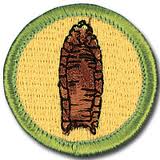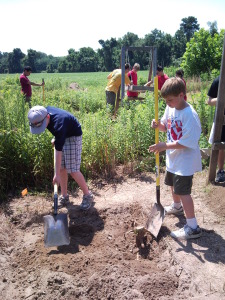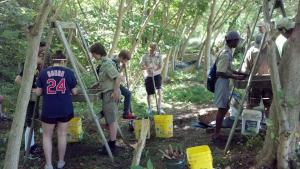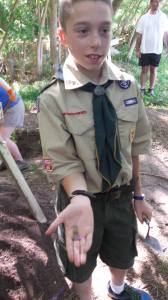Florida. Massachusetts. New Jersey. Yorktown. Throughout the summer season, Boy Scout troops from near and far converge at Fairfield Plantation to try their hand at archaeological excavation under the hot Virginia sun. Many of these Scouts are brought together through the Bayport Scout Reservation in Jamaica, Virginia, where they spend a week working on a variety of scouting activities, as well as engaging in lectures and field trips to work towards merit badges, including archaeology. Every summer dozens of scouts come out to Fairfield for their hands-on lesson in archaeology. The archaeology merit badge requirements suggest that “Scouts will learn what archaeology is and how it benefits today’s society.” The merit badge also falls in line with the Boy Scouts of America’s organizational focus on conservation, creating a direct, tangible link for boy scouts between archaeology and the conservation of fragile and important historic and cultural resources.
The Scouts often show up to the site with some preconceived notions about archaeology, ready and hopeful to discover skeletons, gold, or even dinosaurs. “Are we going to find a skull? That would be so cool! What about gold?! Can I keep what I find?” We’re not out to crush their dreams, but we are hopeful that by spending two hours at Fairfield doing hands-on archaeology, the Scouts will leave with a more realistic understanding of what archaeologists do, and more specifically, what they find and what we learn from the artifacts! These inquisitive Scouts readily accept that they might not find anything as glamorous as portrayed on the big screen, but they are generally curious about the actual artifacts they do encounter – asking questions about the brick, nails, window glass, and ceramics they recover as they sift the dirt through the screens, wondering how these items were used and discarded by people in the past.
Boy Scouts from ages 10 to 18 have participated in excavations across Fairfield – working on test units in the midden to the west of the manor house; aiding in exposing the wonderfully mysterious brick bat foundation to the northeast of the manor house; and braving the poison ivy, ticks, and chiggers by working on units along the tree line to the north of the manor house, helping us expand our sampling grid across the site. Scouts have been present for some pretty exciting artifact finds, as well, including a favorite artifact of many archaeologists, the wine bottle seal – in this case a Nathaniel Burwell wine bottle seal, recovered during the summer of 2011. To see more of this wine bottle seal, check out Culture Embossed.
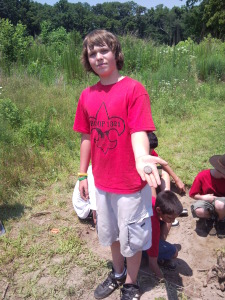
In 2011, a troop of Boy Scouts excavating to the east of the manor house discovered this Nathaniel Burwell wine bottle seal dating to 1715!
But wait, Boy Scouts aren’t the only scouting groups who enjoy getting their hands dirty at Fairfield! Lucky local Girl Scouts have also joined the excavations at the plantation, including one instance in 2004 within the slave quarter area of the plantation, expanding our notions of how many young children can fit into one test unit!
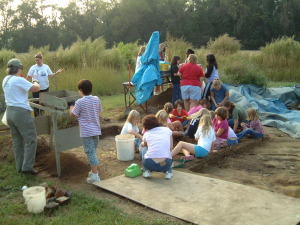
In 2004, a group of Girl Scouts got down in the dirt to help excavate test units in the slave quarter area west of the manor house at Fairfield Plantation
More recently, a Girl Scout troop from Hampton made the trip to Fairfield this May, getting an entirely different experience of the site than those scouts from 10 years ago. Scouts have joined us at Fairfield countless times over the past 14 years, and their interest and energy has helped us move a lot of dirt. They get an introduction to archaeology, and we learn a lot more about the past occupants of Fairfield. It’s a win-win! If you’d like to contact us about bringing your scouting troop to Fairfield, whether to work toward merit badges or just as an interesting hands-on field trip, please contact us at fairfield@fairfieldfoundation.org.
